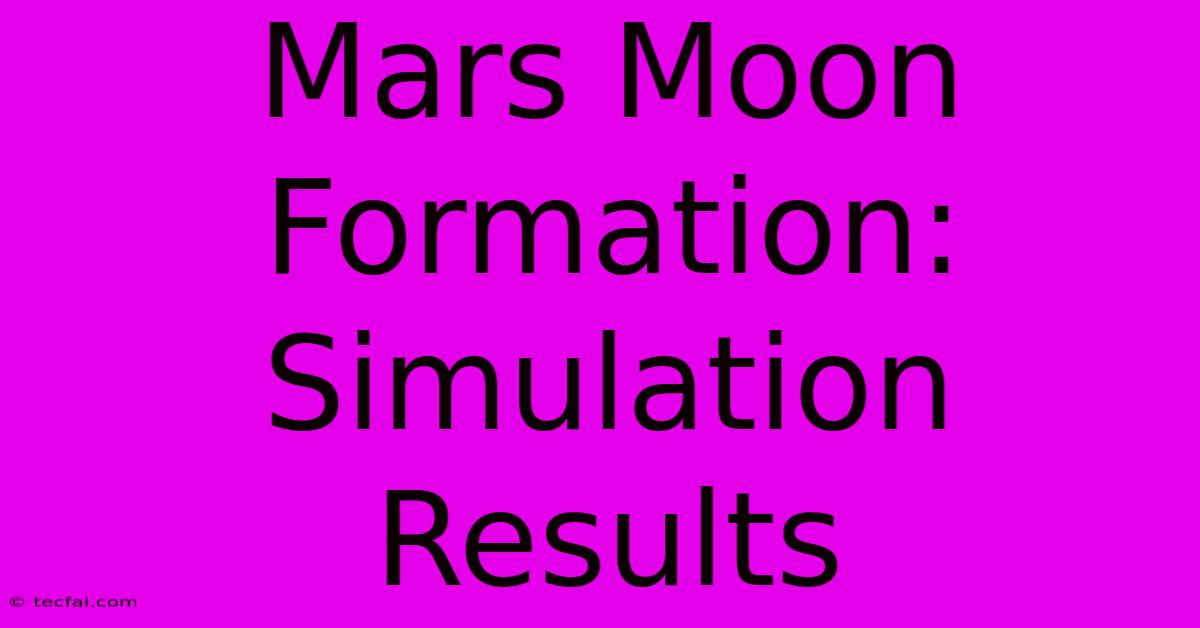Mars Moon Formation: Simulation Results

Discover more detailed and exciting information on our website. Click the link below to start your adventure: Visit Best Website tecfai.com. Don't miss out!
Table of Contents
Mars Moon Formation: Simulation Results Reveal Surprising Insights
The formation of Mars's two moons, Phobos and Deimos, has long been a puzzle for planetary scientists. Unlike Earth's single, large moon, these Martian satellites are small, irregularly shaped, and possess characteristics that don't neatly fit existing theories. Recent advancements in computer simulations, however, are offering exciting new insights into their likely origins. This article will delve into the latest simulation results, exploring the leading hypotheses and the surprising conclusions they've yielded.
The Existing Theories and Their Shortcomings
For years, the leading theory suggested that Phobos and Deimos were captured asteroids. This hypothesis posits that these bodies originated in the asteroid belt and were gravitationally captured by Mars's gravitational pull. However, this theory struggles to account for several key observational facts:
- Orbital characteristics: Phobos and Deimos have relatively circular and equatorial orbits, which are unusual for captured objects. Captured asteroids typically have highly eccentric and inclined orbits.
- Compositional similarities: While not identical, the composition of Phobos and Deimos shows some similarities to Martian rocks, suggesting a possible common origin.
Another, less favored theory proposed that the moons formed in situ from a circumplanetary disk of material surrounding Mars after its formation. However, this theory also faces challenges in explaining the moons' relatively small size and irregular shapes.
New Simulations Shed Light on the Mystery
Recent high-resolution numerical simulations are challenging the established narratives. These simulations, employing sophisticated gravitational models and accounting for the effects of early Mars's environment, are revealing a more nuanced and compelling picture.
The Giant Impact Hypothesis Revisited
One set of simulations strongly supports a modified version of the giant impact hypothesis. This hypothesis suggests that a large impactor struck Mars early in its history, ejecting a significant amount of material into orbit. This ejected material then coalesced to form Phobos and Deimos.
However, the new twist in these simulations lies in the details. They suggest that the impact wasn't a single, catastrophic event but rather a series of smaller impacts over a prolonged period. This gradual accumulation of material could account for the moons' irregular shapes and the less-than-perfect compositional match with Mars.
Implications of the Simulation Results
These simulation results have significant implications for our understanding of planetary formation in general. They challenge the simplistic view of moon formation and highlight the complex interplay of gravitational forces, impact events, and the early environment surrounding a planet.
Specifically, the findings:
- Support a hybrid model: The simulations suggest a combination of impact debris and captured material might contribute to the formation of Phobos and Deimos.
- Refine our understanding of Martian history: The timing and nature of the impacts offer valuable clues to the early bombardment history of Mars.
- Improve models of planetary evolution: These findings provide crucial data for refining and improving computer models used to simulate the formation and evolution of planetary systems.
Future Research and Open Questions
While these simulation results are highly promising, several questions remain unanswered. Further research is needed to:
- Refine the simulation parameters: Improving the accuracy of the models by incorporating more detailed information about Mars's early environment is crucial.
- Analyze Phobos and Deimos samples: Future sample-return missions to Phobos will provide valuable data for validating these simulations.
- Explore alternative scenarios: While the modified giant impact hypothesis seems promising, other scenarios still warrant investigation.
The study of Mars's moons continues to be a dynamic and exciting field. The latest simulation results offer a significant step forward in unraveling the mysteries surrounding their formation, providing crucial insights into the early evolution of our solar system and the processes that shaped the planets and their satellites. As technology advances and new data becomes available, we can expect even more compelling and refined models in the future.

Thank you for visiting our website wich cover about Mars Moon Formation: Simulation Results. We hope the information provided has been useful to you. Feel free to contact us if you have any questions or need further assistance. See you next time and dont miss to bookmark.
Featured Posts
-
T D Jakes Health Incident During Event
Nov 26, 2024
-
More Bank Holidays Uk 2025
Nov 26, 2024
-
Watch Celtics Vs Clippers Tonight
Nov 26, 2024
-
2024 Word Of The Year Announced
Nov 26, 2024
-
Icon Wealth Buys Tjx Companies Stock
Nov 26, 2024
